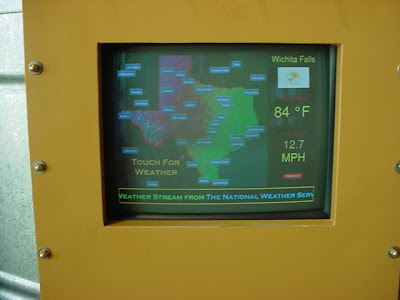
Dan Jenkins once wrote that, "Nothing will turn you into an environmentalist faster than someone building a house that blocks your view of the lake." I believe he's right and that most activism is based in personal experience or belief. As mentioned elsewhere, when I began taking pictures of roadside park structures I did it simply because I liked the way the structures juxtaposed against their settings - particularly those in west Texas. I never really imagined a campaign to "save" any of the parks or structures. I named this blog more or less on a whim. However, the situation is changing.
It's a common story: expansion-minded local politicos decide they want to knock down a public place like a park so as to entice huge corporations to build exclusive neighborhoods with gated compounds protecting million dollar homes surrounded by acres upon acres of concrete retail all of which adds to the tax base which enables the local politicians to buy more land and tear down more green stuff in order to pave more parking lots ... ad nauseum. (I know, Joni Mitchell said it better in only nine words.)
Of course the local pols need something to "harrumph" about in order to justify and mask their destructive intentions so they trot out the local lawman with a fist full of evil statistics and a couple of the usual suspects, a loud chorus of "harrumphing" breaks out, a vote is taken and the deal is done. Another community facility is destroyed - for the good of the community.

Ok, Ok. I am getting way ahead of myself. The bull dozers are not skinning the earth here yet but it looks like they soon may be. And the civic leaders of Flower Mound only "harrumphed" themselves into adopting a resolution to ask TxDOT to close this site because, according to police Captain Wess Griffin, "Its antiquated and obsolete, families are not stopping there," and "it attracts a criminal element."

Joanna Dowling forwarded this article by Wendy Hundley published on August 15, 2009 by the Dallas Morning News entitled, "Flower Mound asks TxDOT to shut down picnic stop on I-35W." (Click on the headline above or cut and paste the link below.)
http://www.dallasnews.com/sharedcontent/dws/news/localnews/stories/DN-reststop_15met.ART0.State.Edition1.4c0abfc.html
I would like to mention to Captain Griffin and the others that, like me, not every traveler has a family or perhaps has the family along on the trip. What about truck drivers? They generally run solo. I am not a highly trained crime observer so maybe I didn't notice all the criminals hanging around when I took these pictures. Maybe the criminals are all in the great hiding places one finds here on the prairies.

I am not sure what the Captain means by "obsolete." What is so objectionable about a table and some shade from the hot Texas sun? Is a place to put your trash obsolete? Don't Mess with Texas, Captain. Unfortunately, Ms Hundley's article ran with only one photo; a black and white depicting a few pieces of trash outside a trash receptacle.

Antiquated? How about unique? I have more than 200 pictures of roadside picnic structures found within the State of Texas, and these in Flower Mound's jurisdiction are the only ones I have found to date that are shaped like the heads of longhorn cattle - which are certainly a Texas icon on the scale of say, the Alamo. At some point, someone obviously thought enough of this park to paint these structures in a Texas flag motif - a very unique and attractive touch by the way.
So I suspect there is more to the story. To get a better view of the broader issues here read the comments to Ms Hundley's article which follow the story at the above mentioned link. Ms Hundley's reporting and the readers comments are certainly worth your time and attention.

And although I mentioned in past entries that I didn't necessarily know that roadside parks in Texas were actually under any real threat, I appears that this one may well be. I will do some more research as time allows and post what I find out soon.






























